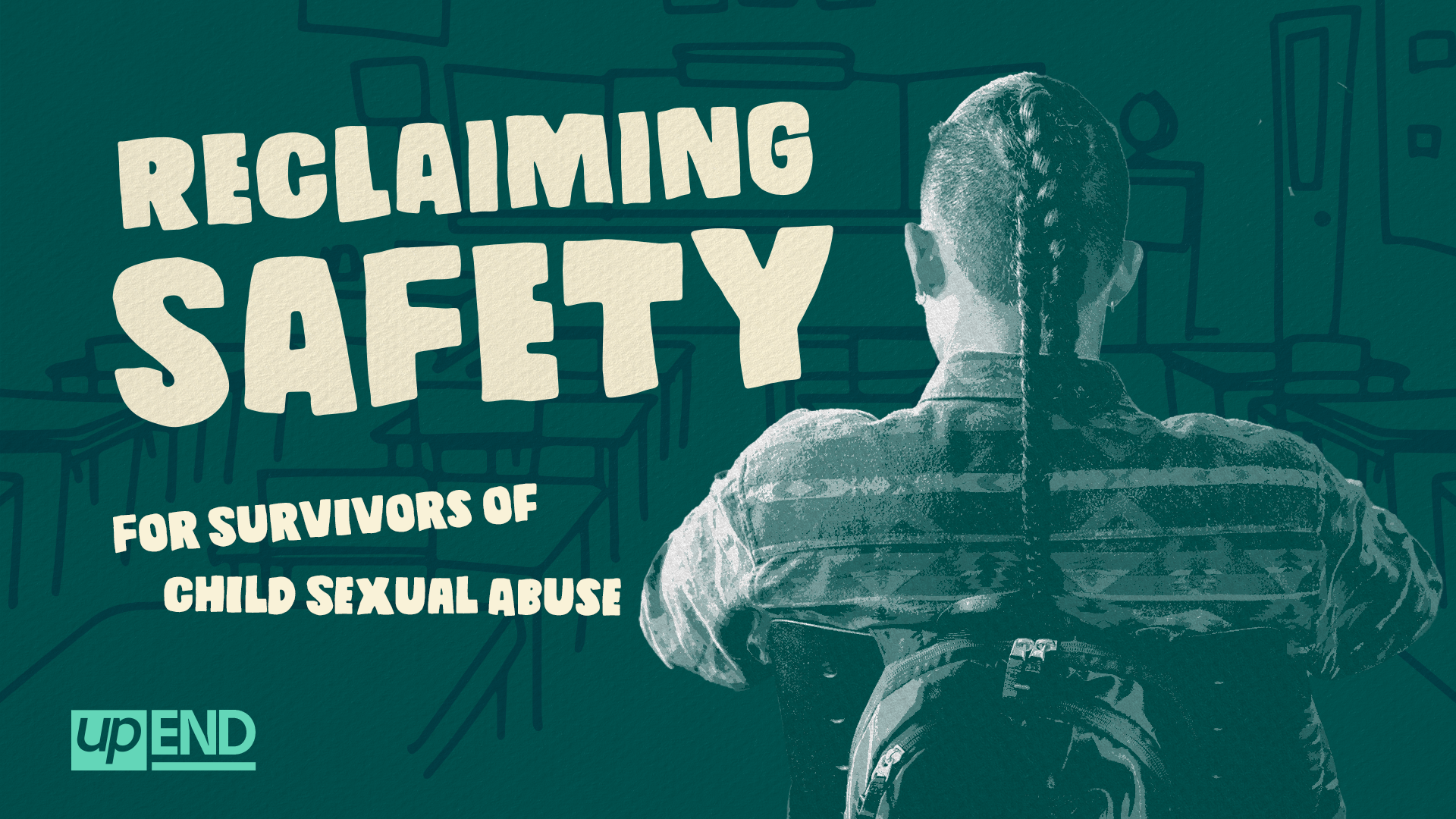Reclaiming Safety for Survivors of Child Sexual Abuse
August 13, 2025
August 13, 2025

by Angela Burton
In Roxanna Asgarian’s contribution to the upEND Movement’s Reclaiming Safety essay series, survivors of child sexual abuse express in their own words what they want and need to feel safe. In contrast to punitive and carceral family policing interventions, we hear survivors of child sexual abuse talk about what real help looks like: responses that provide safety and support, honor family and community relationships with empathy and compassion, and value healing, connection, accountability, and care.
Drawing on the wisdom of survivors, Asgarian posits powerful questions that challenge us to respond more humanely to child sexual harm in ways that prioritize youth agency, center healing, and hold promise for ending intergenerational cycles of harm, silence, pain, and shame.

by Roxanna Asgarian

Trish was 12 years old in 2001 when she was removed from home. Her stepfather had been physically and sexually abusing her in the trailer outside of Conroe, Texas, where they lived. Once she entered foster care, Trish was split from her siblings and moved around to ten different placements, including institutions where she was heavily medicated with psychotropic drugs. In one foster home, her foster parent sexually abused her, too.
“I had a card from my caseworker that said if anything happens, to call this number. I tried to call it and report it, and they said, ‘Okay, we’ll look into it,’” Trish told me years later. “And nothing ever happened.”
Trish aged out of the Texas foster care system at 19. She crashed on friends’ couches for a while, but that didn’t last long. She didn’t know basic life skills like how to drive or how to cook, she was still on multiple heavy-duty psychiatric meds, and she was broke.
That’s how she ended up right back in the Conroe trailer with her mom and stepdad, who was now living as a registered sex offender as a condition of his deferred adjudication. The abuse had stopped, she said, but the family conflicts intensified. That year, she would attempt suicide.
Trish later became a plaintiff in the federal lawsuit against Texas for the failures of its foster system. The lawsuit made clear that, although harrowing, Trish’s story is quite common. Sexual abuse often leads to family separation when CPS gets involved, and the person who harmed a child gets criminalized and added to a sex offender registry. The person who did harm doesn’t get help and often doesn’t take personal accountability for the harm they’ve caused, while survivors like Trish are at increased odds for experiencing repeated sexual abuse both as a child in the foster system and later in life. Once the survivor becomes an adult, they are released into the world with no resources and compounded traumas from their experiences in the foster system. And this is the best case scenario, because the vast majority of child sexual abuse is never even reported or addressed.
Child sexual abuse is a lot more common than many people realize. One landmark CDC study found that one in four girls and one in six boys experience sexual abuse before they turn 18. The research on child sexual abuse over the years has come up with conflicting prevalence numbers, but all of our methods for deducing how common CSA is are imperfect—because research also shows that the majority of children who are sexually abused do not disclose the abuse.
One German study of calls to a sexual abuse hotline found that the average age of disclosure of child sexual abuse is 52 years old—at this age, many people have raised their own children to adulthood. Indeed, official reports to CPS or the police indicate one in 250 children have experienced CSA, but one out of eight people retroactively report having experienced it. Trans and gender nonconforming children are especially vulnerable to child sexual abuse.
The scale of these numbers point to the systemic failures in how we approach child sexual abuse. We have created a culture where children do not feel safe to tell trusted adults when they’ve been harmed, one in which we ask that children navigate the intense and confusing harm of this abuse essentially alone. Because of that, our society is feeding and sustaining intergenerational cycles of harm, silence, pain, and shame.
And the harm of childhood sexual abuse is lasting. Children who have been sexually abused are twice as likely to later be sexually assaulted. A third of CSA survivors report being revictimized. There are strong links between CSA and mental health problems, disability, and coupling with abusive partners—three factors that make parents particularly vulnerable to state surveillance and family separation. Thus, the cycles of harm continue.
Family policing abolitionists have long been grappling with the abuses of a system that should, in theory, be protecting kids. They know the extremely wide net of the child welfare system ensnares far too many for “neglect”—and that neglect is coming not so much from parents struggling with poverty as it is from the state, which for decades has increased policing while slashing social safety-net funding that has been proven to reduce child abuse and neglect.
But what can abolition teach us about responding to instances of actual abuse? It’s clear that our current systems fail here, too. Our typical response to child sexual abuse is to lean on the most punitive responses imaginable, said Aya Gruber, a law professor at the University of Southern California who studies sex exceptionalism in criminal law. That’s because we have created an image of someone who sexually harms children that is devoid of humanity. “We need real and imagined monsters to give us a sense of shared identity, and the sex offender has long played that sort of monstrous role,” Gruber said.
 Conservative politicians lean on tropes about “groomers” and “pedophiles” that drum up support from a wide swath of Americans; myths about child sex trafficking have been shown to be a gateway into extreme beliefs like QAnon. And the laws are getting increasingly punitive. In 2023, Florida passed a law allowing for the death penalty in cases of child sexual abuse involving children under 12. Last year, Tennessee passed a measure allowing the death penalty for cases where a child is raped.
Conservative politicians lean on tropes about “groomers” and “pedophiles” that drum up support from a wide swath of Americans; myths about child sex trafficking have been shown to be a gateway into extreme beliefs like QAnon. And the laws are getting increasingly punitive. In 2023, Florida passed a law allowing for the death penalty in cases of child sexual abuse involving children under 12. Last year, Tennessee passed a measure allowing the death penalty for cases where a child is raped.
“The hysteria leads to really draconian punishments,” Gruber said. “A lot of the research indicates that this actually hurts, not helps, right? So what you end up doing is something that is counter to what you want, which is protecting children from sexual abuse.”
“We want to express our outrage and be so tough that we deter it,” Gruber added. But that approach doesn’t work, “because if you’re too tough, you push things underground.”
Part of the reason disclosure rates are so low is because the punishments, and the stigma, related to sexual abuse of children is so extreme, Gruber said. Laws like this “get passed in a moment of outrage. It’s very popular, because people are imagining monsters—and then everybody touched by that system picks up the pieces.”
Zara Raven is a former foster youth who experienced child sexual abuse while in the foster system. “What I wish had happened would have been to be offered options, to be believed, to be listened to. To have someone that I felt safe talking to, even if I didn’t want any next steps to happen. To know that there was someone who was going to be in my corner to listen and believe me and support me,” Raven said.
What she experienced instead was a feeling that she was completely on her own. She ended up leaving the abusive placement and bouncing around, trying to find safe places to sleep while attending high school unhoused.
“Often adults perpetuate the harms that they experienced,” Raven said. “If adults have not allowed themselves to hold their own experiences of harm, when a child comes to them and says that they’ve been harmed, it’s too much for them to hold, too.”
Raven now engages in activism, including founding a childcare collective aimed at giving children access to multiple safe, trusted adults, and lessening the load for overworked parents. She believes that communities of care, like the one she wished she had growing up, are the way to stop the cycle of abuse that plagues many families and communities without further fracturing them through family separation and incarceration. These intentional communities are also the way to build trust with young people, she said, who deserve to navigate the world with safety and with dignity.
“Kids learn to stop seeking support, to stop seeking help. They will stop sharing with someone who either doesn’t believe them or blames them for what happened to them,” she said. “They will find other ways to navigate their own situation, and they will feel unsupported.”
Part of what makes child sexual abuse so hard to adequately address is that it so often happens inside families. American nuclear families are incredibly insular; what happens inside the home often stays there. Because our only interventions for family violence, including sexual violence, involve the punitive arm of the state, many survivors, especially children, are conflicted about disclosing something that would upend the lives of the entire family.
When the person who is harming you is your parent, or grandparent, or sibling, you may still love and care for them as members of your family. You might recognize the importance they have to your family, as a breadwinner or caretaker, and you might intuit that disclosing the abuse would lead to an extreme response: your loved one could go to prison, you could be separated from your family, or nobody in your family might believe you. All of these things can be devastating for the survivor and their family.
As a child, Staci K Haines was sexually abused by her father. She felt incredibly conflicted, because she loved her dad, and she didn’t want him to be banished from their family, but she also did not want the violence he inflicted on her or her mom to continue.
“Most people, because we’re abused by someone close to us, actually would love some transformation and accountability in that relationship rather than suffering and punishment, because we’re relational creatures,” Haines said.
Haines, who is a leading somatic healer and community activist, said that a main block to achieving this accountability is the visceral shame that comes up when talking about child sexual abuse. “People naturally contract when they hear ‘child sexual abuse.’ That’s a normal trauma response, actually. Of course they’re gonna contract,” she said. “Is there a different doorway that helps people learn to soften, open, and tolerate something that really needs to be seen and worked with?”
For Elizabeth Clemants, that healing work must be done for the entire family. Clemants was a social worker and mediator when she began to see a familiar theme: No matter what was at issue in the mediation, families would circle back to long-held harms within the family from childhood, including sexual abuse. Then roles would start to emerge: The harm-doer, who was often vilified or revered at the expense of the survivor, and sometimes both; the parent bystander, who often felt defensive or would minimize or refuse to acknowledge the role they played; other family members, like siblings, who felt conflicted about the abuse and unable to adequately express the harm they also experienced due to the abuse; and the survivor, who very often felt disbelieved, unloved, and alone in coping with the intense harm they suffered.
“Each person needs help getting to the place where a conversation is different, and where they can show up differently, instead of defensively or by attacking,” Clemants said. She realized that these well-worn roles were extremely hard to untangle, and that the key was to give each person their own space in which to do so. Hidden Water, the nonprofit she founded, holds healing circles made up exclusively of each role in adult families who have experienced child sexual abuse, including those for people who have harmed, people who’ve been harmed, for bystander parents, and for other family members. There are no professionals, no therapists, no one holding court at the front of the room. Instead, each member is someone with personal experience, and the circle keepers are those who have been through the 12-week program before.
“They just witness, without being attacked or judged or anything, other people facing it down, and then little by little, because no one’s making them do it, or trying to convince them, they’re just sitting in a place where they can say whatever’s true for them in that moment, and ultimately, they start to shift in these amazing ways,” Clemants said.
Aishah Shahidah Simmons, a CSA survivor and filmmaker who edited Love WITH Accountability, an anthology by and for Black survivors of child sexual abuse, said that an accountability process outside the prison or family policing system opens up possibilities for true acknowledgement and healing.
“I think that in many ways, transformative justice really helps us to face the unfaceable and talk about it, without demonizing,” Simmons said. “People have committed heinous and monstrous acts. But does that make them a monster? And I’m not saying—especially for survivors in the initial stages, they have shit to work out and figure out, that’s not their job. But in terms of our communities and our families, that’s our job, right?”
 In a culture where punishment is the norm and incarceration and family separation is posed as the only solution to every type of harm, child sexual abuse engenders a particularly heated and vengeful response. It’s hard for most people, even progressive ones, to see people who have sexually abused a child as deserving of empathy.
In a culture where punishment is the norm and incarceration and family separation is posed as the only solution to every type of harm, child sexual abuse engenders a particularly heated and vengeful response. It’s hard for most people, even progressive ones, to see people who have sexually abused a child as deserving of empathy.
“People think acknowledging it means throw them out with the trash, or put them in jail for life, or never talk to them again, or get divorced, or all the good things that you’ve ever shared with them were wrong,” Clemants said. But the reality is more complex, and true accountability requires sitting with the humanity of each person involved—including the person who did the harm.
Mike Milton understands that better than most. Milton grew up in Penrose, a mostly Black neighborhood in St. Louis. The area was intentionally divested from, overpoliced, and under-resourced, but it was also where he learned the value of community. It was clear to him even as a child that the neighborhood residents were likely the only ones who would step in to take care of each other.
“When someone died in our community, we would raise money to help them bury their child, or if someone couldn’t go to work because they needed childcare, we found a neighborhood childcare person, a living room of a grandma who couldn’t work anymore,” Milton said. “I was able to see in real time what happens when a community gets responsibility for each other.”
Milton experienced sexual abuse for years as a child, and as a result, he struggled. He didn’t know how to process it, and was ashamed of it, so he tried to run from it. He ended up in and out of jail and prison as a teen and young adult. He also harmed other people during this time. “Not knowing how to handle my sexuality, how to handle masculinity, ego, and having to prove that I was not soft or queer or whatever the case may be—I took on an identity that was protective, it kept me safe from judgment,” he said.
When he left prison for the last time, he met someone that transformed his life. “They heard all of the deep hard shit that I did to people, and they didn’t judge me, they created space for empathy,” Milton said. “They showed me that the power of transformation is actually just compassion.”
He began to heal from the abuse he experienced as a child, and he began to show other men who had done harm how to look directly at their own pain and shame. He founded Freedom Community Center in St. Louis, which uses transformative justice to work through interpersonal harm, including child sexual abuse. Sometimes that looks like intervening before someone calls the police; other times, they will step in after someone is incarcerated to do a restorative justice process with those involved.
The organization is explicitly abolitionist, but Milton stresses that the goal isn’t always repair. “The aim isn’t always to bring their relationships back to each other; sometimes it is about, ‘What type of conditions can we create so that we can make sure that they never do this again and they’re all able to move forward?’”
—
The carceral response to child sexual abuse is one-size-fits-all. A child discloses to a mandated reporter, who makes a report to the police or CPS. Police and prosecutors try to collect evidence and build a case. The goal of this process is for the harm-doer to end up incarcerated. On a separate track, CPS starts a case, investigating the family, turning over rocks to see what they find. Sometimes the child is removed from home, further isolating them in an already traumatizing moment. Whatever the result, children’s lives are thrown into disarray, seemingly just an afterthought to the pursuit of punishment.
With abolition, of course, the response is so much more complex—but so, too, are these situations. Using a sledgehammer approach on a vulnerable family often does more harm than good, and very little thought is given to what a survivor of child sexual abuse actually needs to find healing.
Ultimately, the survivor is the primary person who has to live with the effects of the abuse. They’ve got the rest of their lives, and they deserve not just the safety to begin to heal but the agency to have a say in that process. Transformative justice gives space for that. By humanizing every person involved, and prioritizing healing, the goal is to change a harmful family dynamic into one of accountability, where cycles of harm can be broken and children can be safe and free to grow uninhibited.
“We cannot let this keep happening to us. Something has to break,” Milton said. “We tried everything. We tried secrecy, we tried prison, we tried ostracization. We tried it all. But this keeps happening. So for the sake of our children, our grandchildren, let’s figure out something new.”

Survivor-focused
What does the child need to be safe? Have you engaged them in a sensitive conversation that centers their thoughts and feelings (and not yours)? What do they need to feel safe? What do they want to happen? How can you give them as much agency as possible while still ensuring their safety?
Community-oriented
Who are the people closest to the child inside the home? Who are their family members outside the home? Does this child have safe adults who care for them outside the family? List all of these people—this is the child’s care team. Engage all of these folks in conversations about the best way to care for the child moving forward; connect with each other together and separately. Implement immediate plans for safety, but continue thinking of how you all will support the child’s healing long term.
Safety planning
What is the position of the person who did the harm to the family? Are there other factors, like mental health problems, substance misuse, or abuse of other people in the home? Does the person who did the harm make contributions (financial or otherwise) to the home, and how might those contributions be met if that person was removed from the home? Does the child have a safe parent, and how can they best be supported? Think through the economic and home situation to devise a safety plan with the child’s care team that meets everyone’s basic survival needs. Take the child’s stated needs for what they need to feel safe seriously.
Transformation and accountability
How might the harm-doer be engaged in accountability? Are they willing? Seek counsel from community members and others who are experienced in transformative justice. Engage a care team for the harm-doer, if that’s possible—try to make these different people than the child’s care team, with clear obligations for everyone involved. Decide as a community what the boundaries for safety are regarding the person who did the harm, and enforce those boundaries. What are the consequences? Think practically here, but center the needs and feelings of the child.
Healing spaces for each impacted person
What spaces can you create or join that give each impacted family member a place to seek support? Brainstorm ideas—this can be a holistic response, beyond just therapy. Are there healthy ways to grow the confidence of the child, and increase their feelings of belonging, within or outside the home?
 Roxanna Asgarian is a Texas-based journalist and the author of We Were Once a Family: A Story of Love, Death, and Child Removal in America, which won the 2023 National Book Critics Circle Award for Nonfiction, the Andrew Carnegie Medal for Excellence in Nonfiction, and the L.A. Times Book Prize. She is a survivor of child sexual harm who has reported extensively on child abuse, child well-being, and the harms of the family policing system.
Roxanna Asgarian is a Texas-based journalist and the author of We Were Once a Family: A Story of Love, Death, and Child Removal in America, which won the 2023 National Book Critics Circle Award for Nonfiction, the Andrew Carnegie Medal for Excellence in Nonfiction, and the L.A. Times Book Prize. She is a survivor of child sexual harm who has reported extensively on child abuse, child well-being, and the harms of the family policing system.
Asgarian, R. (2025). Reclaiming Safety for Survivors of Child Sexual Abuse. upEND Movement. upendmovement.org/safety